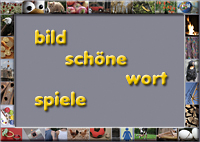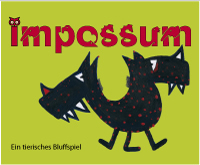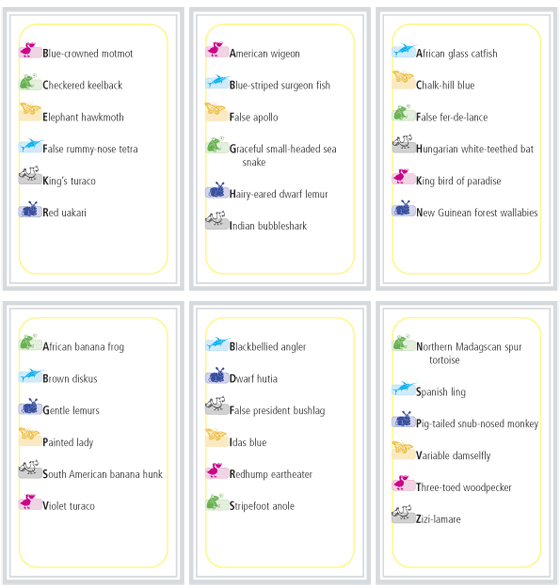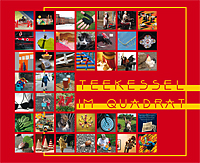
Picturesque Word Games
 Bildschöne
Wortspiele (Picturesque Word Games) is a compact collection of 8 card
games that deal with images and associated words. The games
are well-suited for cross-generational, highly communicative playing.
They have also been designed for educational and therapeutical purposes
(language training, speech therapy) and are frequently used in these
contexts. The emphasis being on addressing families, the training and
therapeutic impacts are held in the background. Yet they are obvious
and easy to functionalize for experts.
Bildschöne
Wortspiele (Picturesque Word Games) is a compact collection of 8 card
games that deal with images and associated words. The games
are well-suited for cross-generational, highly communicative playing.
They have also been designed for educational and therapeutical purposes
(language training, speech therapy) and are frequently used in these
contexts. The emphasis being on addressing families, the training and
therapeutic impacts are held in the background. Yet they are obvious
and easy to functionalize for experts.
Download: English rules ![]() (2 MB)
(2 MB)
 The main
principle
The main
principle
All games are played with the photos shown on the cards. The principal mechanism is very simple: You form compounds by combining the words that you associate with two or more photos. An example:
 +
+ 
With photo no.1 and photo no. 2 you can form “eagle eyes”
It is important to note, that a photo doesn’t just represent only one word. For instance, for photo No. 1 you can also say “bird” (and form “bird bath”, “bird table”, “frigate bird”, “game bird” in combination with other cards in the set) or “animal” (and form “pack animal”, “stuffed animal”, “animal farm” or “animal world”) or “beak”, or “head”, or “feather” and so on.
The selection of the photos ensures that you can form a large number of compounds without leaving the range of basic vocabulary. Of course you can integrate words from special languages and colloquial language and thus widen the linguistic range. This can be useful for generating more fun when played within the family or for the training of vocabulary or stylistic competence.
 Why use
photos?
Why use
photos?
We chose photos instead of drawn pictures because we think that in game contexts photos, when carefully selected, are better-suited to stimulate imagination and emotions than small drawn pictures. We observed that photos generate more stimulus for associating of words with the pictures. There is just more to see. And players’ imagination is charged instead of being limited to a restricted semantic scope.
Some examples:
![]() +
+ ![]() -- eyeglass
-- eyeglass
![]() +
+ ![]() -- eyeball
-- eyeball
![]() +
+ ![]() +
+ ![]() -- football
game
-- football
game
 Description
of the games
Description
of the games
Content: The set contains 100 cards (89 photos, 6 jokers, 5 blancs), 4 cards with suggestions for words, 1 booklet with rules and examples.
Demands: All the games are a challenge for imagination and linguistic competence. As regards competence it is not crucial for players to have “academic” background. What matters is to be curious, to “listen” to one’s imagination, and to be active.
When playing with the photos people discover words and combinations of words. Playing Bildschöne Wortspiele is musing about words.
In educational contexts the games cannot only be used for vocabulary training. It is also possible to train more subtle competences such as abstract thinking (eagle > bird > animal), the perception of paralleles and differences (bird – bird of prey : singing bird) and narrating (you put down one card after another and let narrate / narrate yourself).
When played within the family, children are likely to find other words than grown-ups. This is a precious contrast that sustains dialogue between the generations. We often heard that in playgroups each player had selected one photo as their favourite picture. When being asked why they had selected that particular photo we were often rewarded by being told a whole story. Would you get that from small drawn images?
You can play most of the games either in competition or in coordination. Some of the games you can even play on your own.
Depending on which game is played, the emphasis is on speed, concentration, memory, or wit. Licences
Licences
We are interested in negotiating about licences with other publishers. Bildschöne Wortspiele have been designed on the basis of a database with German compounds. The mechanism, however, works in English as well, except for the possibility of forming very long compounds that are built by connecting 5 or even more words, which is possible in German with many of the cards (this however is not crucial).
Please contact us, when you are interested.
The game "Impossum"
 Impossum is a small collection of 3 card games that
deal with very strange names of animals. Designed as family games and
party games, Impossum intends to procure fun by direct communication
between the players. You deal with queer animal names such as "blood-striped
blenny", "bobolink", "spectacled warbler", "brown
egg frog". So you should have some liking for handling language
in a playful manner.
Impossum is a small collection of 3 card games that
deal with very strange names of animals. Designed as family games and
party games, Impossum intends to procure fun by direct communication
between the players. You deal with queer animal names such as "blood-striped
blenny", "bobolink", "spectacled warbler", "brown
egg frog". So you should have some liking for handling language
in a playful manner.
Communication is the core of the games. In two of them bluffing is necessary to stand a chance for winning. Impossum has no strategic elements.
In all three games you try to get rid of your cards. Each card shows six names of animals, each of them belonging to a different species: mammals, reptiles, fish, birds, butterflies, and Impossums. The categories are represented by icons referring to the names. Only the first five species are "regular" species. The animals listed on the cards belonging to these species really do exist. The Impossums however are impossible animals. Their sole purpose is to provide suggestions for bluffing.
 Impossum
(2008)
Impossum
(2008)
The most demanding game of the three was published in 2008. First, a reference animal is selected. Then the players compete in putting down their cards. There is a set of rules for putting down cards, based on alphabetical and morphemic criteria referring to the animal names. When putting down a card you must pronounce the name of the animal that in fact or allegedly fits to the rules. You don’t show the face of the card. So bluffing is always possible. If you have no “real” animal with an appropriate name you can put down an Impossum or invent an animal. But: Each card put down can be controlled. When your bluffing is detected, you get malus points. However, when you have put your card down "regularly", the one who has controlled it gets malus points.
Chances are good not to be detected when bluffing: all animal names (more than 1250) are very strange indeed so it is not obvious when you invent a name on your own or use an Impossum. Unless you blush...
 Impossum
light (New 2009)
Impossum
light (New 2009)
The alphabet is relevant: You put down cards in alphabetical order. Much easier to play than Impossum and probably best suited for parties, but less thrilling than Impossum. Practicable for Children at the age of 8.
 Impossum
guess (New 2009)
Impossum
guess (New 2009)
You guess to what species an animal belongs. When you guess correctly, it’s your turn to go on. As the animals must be pronounced aloud the game is a good exercice for reading and pronunciation.
 Licences
Licences
We are interested in negotiating about licences for other publishers. Impossum has been designed on the basis of strange animal names in German. The mechanisms, however, work in many languages. They do work nicely in English. The customizing of the animal names could be achieved on the basis of the database of the animal names that we have established. So the research work has already been accomplished. Of course, there would be some amount of lectoral work to do.
Please contact us, when you are interested.
See some prototype cards with English animal names (real ones and Impossums) below.

Teekessel im Quadrat

Teapot (or "Teekessel" in German) is a game that is based on play with homonyms. Homonyms are words that have the same spelling or sound but different meanings.